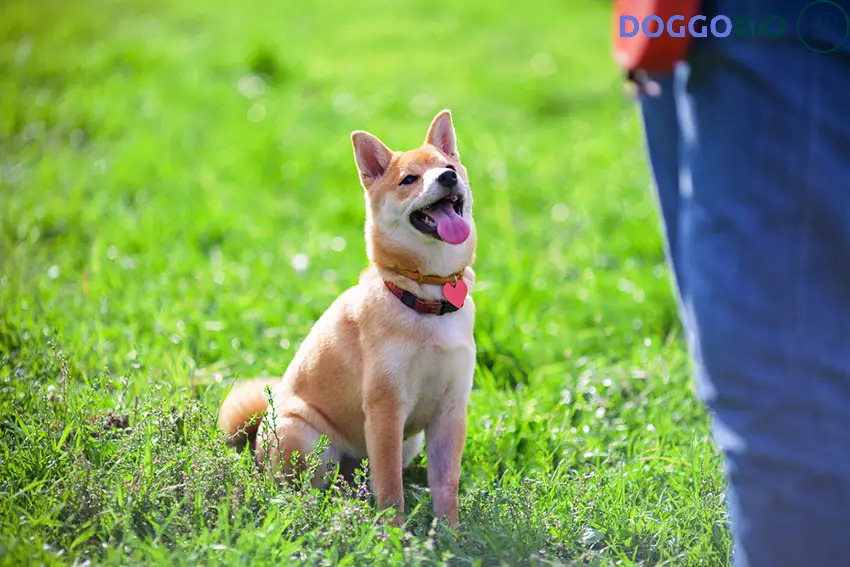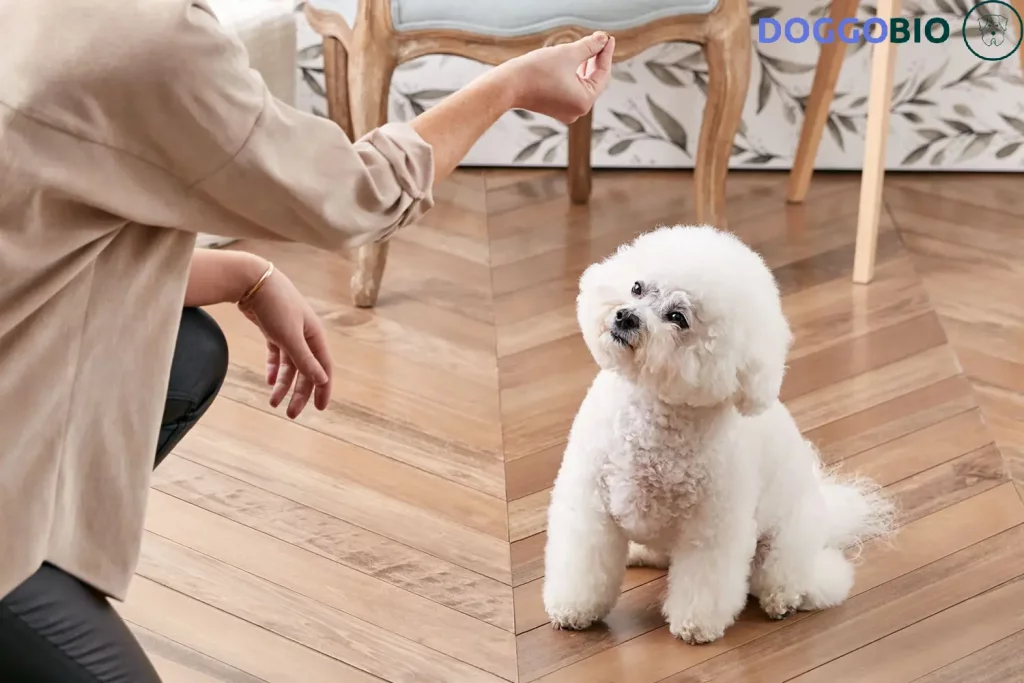Welcome to this guide on how to teach a dog to sit on command! Teaching your dog basic obedience commands like “sit” can make a big difference in their behavior and strengthen the bond between you and your furry friend.
This guide will walk you through teaching your dog to sit, including the importance of positive reinforcement and consistency. Whether you’re a first-time dog owner or just looking to improve your training skills, this guide will provide the information you need to teach your dog this fundamental command. So, grab some treats, and let’s get started!
When Can I Start Teaching My Dog Sit On Command?

The question of when to initiate obedience training for a puppy often leaves many pet owners at a loss. However, the truth is that pups as young as 6 to 8 weeks old are more than capable of mastering rudimentary obedience commands such as “sit” and “stay.” The early developmental stages of a young dog are pivotal in their cognitive and behavioral development and, therefore, should not be neglected. It is worth noting that even older dogs without mobility impairments can also be taught the “sit” command.
The importance of early obedience training for a young pup cannot be overstated. This early stage of life is critical for establishing a solid foundation of basic obedience commands, which will serve as a framework for more advanced training later on. Consistency and patience are crucial components of the training process, as is the incorporation of positive reinforcement in the form of treats and praise. By investing time and effort in obedience training at an early age, pet owners can look forward to a lifetime of well-behaved and obedient furry companions.
How to Teach a Dog to Sit?

1.Determine Sitting Position
Understanding the proper sitting position for your furry friend is a crucial element of successful canine training. It requires a nuanced understanding of dog behavior, an eye for detail, and a willingness to devote the time and effort necessary to achieve optimal results.
Your dog’s hocks and bottom must be firmly and securely planted on the ground to achieve the ideal sitting position. However, it is not uncommon for some dogs to attempt to cheat and hover slightly above the ground. In such cases, rewarding your furry friend when its rear end is firmly on the floor is crucial.
Remembering that ideal sitting behavior involves remaining in the sitting position until you release your furry companion with a cue. Many trainers use “OK” as a release cue, but finding the best signal for you and your furry friend is vital.
However, achieving this level of obedience and discipline may take time and consistent training. Set aside 5 to 10 minutes a few times weekly to perfect your furry friend’s sitting behavior. With the right tools, techniques, patience, and persistence, you can help your furry friend become a well-behaved and obedient companion in no time.
2.Reward The Treats
Teaching your furry friend to respond to dog treats is a fundamental aspect of canine training that requires finesse, patience, and a keen understanding of your dog’s behavior.
The first step in using treats to train your dog is to grab its attention by showing it that you have a treat in your hand. It’s crucial to hold the treat at the right level, not too high, or your dog might jump, and not too low that it loses interest. Move the treat back towards your dog’s ears, keeping it close to the head. It’s normal for your dog’s nose to turn up to follow the treat initially, but most dogs will eventually sit when the treat gets to a certain point.
Once your furry friend has landed on its rear, it’s time to reward its obedience with positive reinforcement. Say “yes!” or “good dog” in an upbeat tone or click your clicker, then immediately offer your furry friend the treat, followed by some petting and praising.
Remember, achieving optimal results with this technique requires high consistency and repetition. Don’t be discouraged if your furry friend doesn’t get it immediately. Keep practicing for 5 to 10 minutes a few times a week, and before you know it, your furry friend will respond to dog treats like a pro.
3.Repeat With Cue Word
Using a consistent cue word is essential when teaching your dog to sit. To start:
- Get your dog’s attention by showing them a treat and holding it above their nose. As you move the treat back towards their ears, their nose will follow, and they will likely sit down.
- When they do, praise them enthusiastically and give them the treat.
- Repeat this several times until your dog starts to sit when they see the treat above its nose.
Now it’s time to add the cue word. Call your dog’s name and say “sit” in a clear and firm voice while holding the treat in the same position. Repeat this step several times, using the word “sit” each time, and gradually reduce the hand motion while still giving your dog a treat. With practice, your dog will learn to associate the cue word with the action of sitting. Consistent training is crucial to success, so work on this exercise for a few minutes each day.
4.Training, More and More
Mastering any skill, including dog training, requires consistent and unwavering practice. The arduous task of dog training necessitates the adoption of a daily training regimen, with short and frequent training sessions throughout the day.
Varying these sessions’ locations, indoors and outdoors, is imperative to naturally increase the environmental distractions to which the dog is exposed. It is paramount that the dog can execute the “sit” command regardless of the surrounding distractions. The culmination of each training session must be punctuated with positive reinforcement in the form of dog treats, as this will reinforce the desired behavior. Maintaining patience and composure throughout the training process is vital for success.
5.Behavior tracking
It’s important to note that if your furry friend doesn’t sit independently after a few attempts, avoid forcefully pushing it into a sitting position. This can cause confusion or upset. Instead, consider using positive reinforcement techniques like offering more valuable treats like fresh meat, hot dog pieces, and string cheese. Negative reinforcement, like yelling or punishment, rarely produces the desired results and can create confusion in dogs.
If using valuable treats doesn’t work, try marking the behavior. Observe your furry friend and reward it every time it sits on its while saying the word “sit.” Remember to carry treats and a clicker with you at all times. Once your dog knows how to sit on command, prove the behavior by training it in different locations with varying distractions.
Tips for teaching your dog to sit on command

Are you ready to train your dog to sit on command? Here are some tips to get you started:
- Be patient and stay positive! It takes time and effort to teach your dog new skills.
- Don’t force your dog’s rear end down to the ground. This can be intimidating and confusing for them. Instead, use positive reinforcement techniques like treats and verbal praise to encourage them to sit.
- If your dog isn’t getting it, try changing up your methods. A different treatment may be more enticing, or a new training location will help them focus.
- Turn sitting into a “default behavior” by rewarding your dog whenever they sit on its own. This will help them associate sitting with positive experiences and make it more likely they’ll sit on command in the future.
Remember, training your dog takes time and patience. With consistent practice and positive reinforcement, your pup will soon be sitting on command like a pro!
Conclusion
In conclusion, teaching your dog to sit on command is an essential step in their training and can help improve their behavior and strengthen your relationship with them. By following the steps outlined in this guide and using positive reinforcement techniques, you can teach your dog this fundamental command in an effective and enjoyable way for you and your furry friend.
Remember to be patient and consistent, and always to use positive reinforcement, as this will help ensure that your dog understands what is expected of them and that they continue to obey the “sit” command in the long term. With practice and perseverance, your dog will be sitting on order like a pro in no time!
